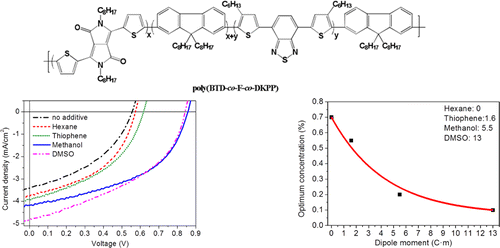
The influence of various polar solvent additives with different dipole moments has been investigated since the performance of a photovoltaic device comprising a donor–acceptor copolymer (benzothiadiazole-fluorene-diketopyrrolopyrrole (BTD-F-DKPP)) and phenyl-C60-butyric acid methyl ester (PCBM) was notably increased. A common approach for controlling bulk heterojunction morphology and thereby improving the solar cell performance involves the use of solvent additives exhibiting boiling points higher than that of the surrounding solvent in order to allow the fullerene to aggregate during the host solvent evaporation and film solidification. In contrast to that, we report the application of polar solvent additives with widely varied dipole moments, where intentionally no dependence on their boiling points was applied. We found that an appropriate amount of the additive can improve all solar cell parameters. This beneficial effect could be largely attributed to a modification of the poly(3,4-ethylenedioxythiophene):poly(styrenesulfonate) (PEDOT:PSS)-active layer interface within the device layer stack, which was successfully reproduced for polymer solar cells based on the commonly used PCDTBT (poly[N-900-hepta-decanyl-2,7-carbazole-alt-5,5-(40,70-di-2-thienyl-20,10,30-benzothiadiazole)]) copolymer.